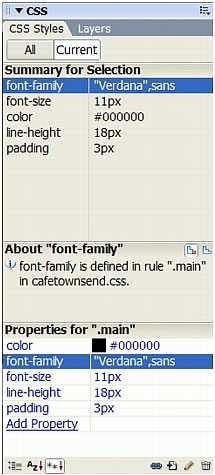The CSS Styles panel in Current mode
The CSS Styles panel in Current mode
In Current mode, the CSS Styles panel displays three panes: a Summary for Selection pane that displays the CSS properties for the current selection in the document, a Rules pane that displays the location of selected properties (or a cascade of rules for the selected tag, depending on your selection), and a Properties pane that lets you edit CSS properties for the rule defining the selection.

You can resize any of the panes by dragging the borders between the panes.
The Summary for Selection pane displays a summary of CSS properties for the item currently selected in the active document. The summary shows the properties for all rules that directly apply to the selection. Only set properties are shown.
For example, the following rules create a class style and a tag (in this case paragraph) style:
.foo{
color: green;
font-family: ‘Arial’;
}
P{
font-family: ‘serif’;
font-size: 12px;
}
When you select paragraph text with a class style of .foo in the Document window, the Summary for Selection pane displays the relevant properties for both rules, because both rules apply to the selection. In this case, the Summary for Selection pane would list the following properties:
font-size: 12px font-family: ‘Arial’ color: green
The Summary for Selection pane arranges properties in increasing order of specificity. In the above example, the tag style defines the font size and the class style defines the font family and the color. (The font family defined by the class style overrides the font family defined by the tag style because class selectors have higher specificity than tag selectors. For more information on CSS specificity, see www.w3.org/TR/CSS2/cascade.html.)
The Rules pane displays two different views--About view or Rules view--depending on your selection. In About view (the default view), the pane displays the name of the rule that defines the selected CSS property, and the name of the file containing the rule. In Rules view, the pane displays a cascade, or hierarchy, of all rules that apply directly or indirectly to the current selection. (The tag to which the rule directly applies appears in the right column.) You can toggle between the two views by clicking the Show Information and Show Cascade buttons in the upper-right corner of the Rules pane.
When you select a property in the Summary for Selection pane, all of the properties for the defining rule appear in the Properties pane. (The defining rule is also selected in the Rules pane, if Rules view is selected.) For example, if you have a rule called .maintext that defines a font family, font size, and color, then selecting any of those properties in the Summary for Selection pane will display all of the properties defined by the .maintext rule in the Properties pane, as well as the selected .maintext rule in the Rules pane. (Additionally, selecting any rule in the Rules pane displays that rule’s properties in the Properties pane.) You can then use the Properties pane to quickly modify your CSS, whether it is embedded in the current document or linked by means of an attached style sheet. By default, the Properties pane shows only those properties that have been previously set, and arranges them in alphabetical order.
You can choose to display the Properties pane in two other views. Category view displays properties grouped into categories, such as Font, Background, Block, Border, and so on, with set properties at the top of each category, displayed in blue text. List view displays an alphabetical list of all available properties, and likewise sorts set properties to the top, displaying them in blue text. To switch between views, click the Show Category View, Show List View, or Show Only Set Properties button, located at the lower-left corner of the Properties pane.
In all views, set properties are displayed in blue; properties irrelevant to a selection are displayed with a red strike-through line. Holding the mouse over a rule that is irrelevant displays a message explaining why the property is irrelevant. Typically a property is irrelevant because it’s overridden or not an inherited property.
Any changes you make in the Properties pane are applied immediately, letting you preview your work as you go.
Related topics
- The CSS Styles panel in All mode
- Using the CSS Styles panel
 |  |






